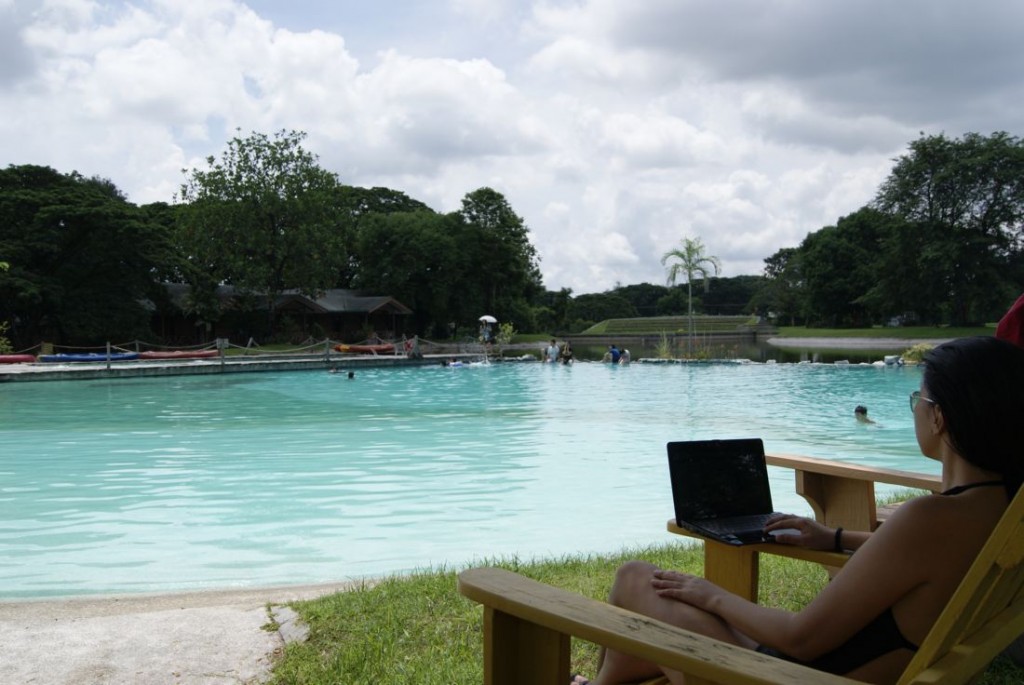Golf – 24August11
Golf is a precision club-and-ball sport, in which competing players (or golfers), using many types of clubs, attempt to hit balls into each hole on a golf course while employing the fewest number of strokes.
It is one of the few ball games that does not require a standardized playing area. Instead, the game is played on golf “courses”, each of which features a unique design, although courses typically consist of either nine or eighteen holes. Golf is defined, in the rules of golf, as “playing a ball with a club from the teeing ground into the hole by a stroke or successive strokes in accordance with the Rules.”
Golf competition is generally played for the lowest number of strokes by an individual, known simply asstroke play, or the lowest score on the most individual holes during a complete round by an individual or team, known as match play.
Origin
Main article: History of golf
The origin of golf is unclear and much debated. Some historians[3] trace the sport back to the Roman game of paganica, in which participants used a bent stick to hit a stuffed leather ball. One theory asserts that paganica spread throughout Europe as the Romans conquered most of the continent, during the first century BC, and eventually evolved into the modern game.[4] Others cite chuiwan (“chui” means striking and “wan” means small ball) as the progenitor, a Chinese game played between the eighth and fourteenth centuries.[5] A Ming Dynasty scroll dating back to 1368 entitled “The Autumn Banquet” shows a member of the Chinese Imperial court swinging what appears to be a golf club at a small ball with the aim of sinking it into a hole. The game is thought to have been introduced into Europe during the Middle Ages. Another early game that resembled modern golf was known as cambuca in England and chambot in France.[6] This game was, in turn, exported to the Low Countries, Germany, and England (where it was called pall-mall, pronounced ŌĆ£pell mellŌĆØ).[citation needed] Some observers,[who?] however, believe that golf descended from the Persian game, chaug├Īn. In addition, kolven (a game involving a ball and curved bats) was played annually in Loenen, Netherlands, beginning in 1297, to commemorate the capture of the assassin of Floris V, a year earlier.
The modern game originated in Scotland, where the first written record of golf is James II’s banning of the game in 1457, as an unwelcome distraction to learning archery.[7]
Golf course
A golf course consists of a series of holes, each with a teeing ground that is set off by two markers showing the bounds of the legal tee area, fairway, rough and other hazards, and the putting green surrounded by the fringe with the pin (normally a flagstick) and cup.
The levels of grass are varied to increase difficulty, or to allow for putting in the case of the green. While many holes are designed with a direct line-of-sight from the teeing area to the green, some holes may bend either to the left or to the right. This is commonly called a “dogleg”, in reference to a dog’s knee. The hole is called a “dogleg left” if the hole angles leftwards and “dogleg right” if it bends right. Sometimes, a hole’s direction may bend twice; this is called a “double dogleg”.
A typical golf course consists of eighteen holes but nine-hole courses are common and can be played twice through for a full round of eighteen holes.[8][9]
Early Scottish golf courses were primarily laid out on links land, soil covered sand dunes directly inland from beaches.[10] This gave rise to the term golf links, particularly applied to seaside courses and those built on naturally sandy soil inland.
The first eighteen-hole golf course in the United States was located on a sheep farm in Downers Grove, Illinois, in 1892. The course is still situated there today.[11]
Play of the game
Every round of golf is based on playing a number of holes in a given order. A ’round’ typically consists of eighteen holes that are played in the order determined by the course layout. On a nine-hole course, a standard round consists of two consecutive nine-hole rounds.
Playing a hole on a golf course is initiated by putting a ball into play by striking it with a club on the teeing ground (also called the tee box, or simply the tee). When this initial stroke (or ‘shot’) is required to be long due to the length of the hole, it is usual (but not required) for a golfer to suspend (or ‘tee-up’) the ball on a tee prior to striking it. A tee in this last sense is a small peg which can be used to elevate the ball slightly above the ground up to a few centimetres high. This elevation is at the discretion of the golfer. Tees are commonly made of wood but may be constructed of any material; the ball may even be teed on a mound of grass or dirt (at one time a small pile of sand placed by the golfer was routinely used and sand was provided at teeing grounds for golfers’ use).
When the initial shot on a hole is a long-distance shot intended to move the ball a great distance down the fairway, this shot is commonly called a ‘drive’. Shorter holes generally are initiated with shorter clubs called irons. Once the ball comes to rest, the golfer strikes it again as many times as necessary using shots that are variously known as a ‘lay-up’, an ‘approach’, a ‘pitch’, or a ‘chip’, until the ball reaches the green, where he or she then ‘putts’ the ball into the hole (commonly called “sinking the putt”). The goal of getting the ball into the hole (“holing” the ball) in as few strokes as possible may be impeded by obstacles such as areas of long grass called ‘rough’ (usually found alongside fairways) which both slows any ball that contacts it and makes it harder to advance a ball that has stopped on it, bunkers (or sand traps), and water hazards.[8] In most forms of gameplay, each player plays his or her ball until it is holed.
Players can walk to their next shot or drive in golf carts over the course. The game can be played either individually or in groups and sometimes accompanied by caddies, who carry and manage the players’ equipment and who are allowed by the rules to give advice on the play of the course.[12] A caddy’s advice can only be given to the player or players for whom the caddy is working, and not to competing players.
Rules and regulations
Main article: Rules of golf
The rules of golf are internationally standardised and are jointly governed by The R&A, spun off in 2004 from The Royal and Ancient Golf Club of St Andrews(founded 1754), and the United States Golf Association (USGA).[13][14]
The underlying principle of the rules is fairness. As stated on the back cover of the official rule book:
Play the ball as it lies, play the course as you find it, and if you cannot do either, do what is fair.
There are strict regulations regarding the amateur status of golfers.[15] Essentially, anybody who has ever received payment or compensation for giving instruction, or played golf for money, is not considered an amateur and may not participate in competitions limited solely to amateurs. However, amateur golfers may receive expenses which comply with strict guidelines and they may accept non-cash prizes within the limits established by the Rules of Amateur Status.
In addition to the officially printed rules, golfers also abide by a set of guidelines called golf etiquette. Etiquette guidelines cover matters such as safety, fairness, pace of play, and a player’s obligation to contribute to the care of the course. Though there are no penalties for breach of etiquette rules, players generally follow the rules of golf etiquette in an effort to improve everyone’s playing experience.
Penalties
Penalties are incurred in certain situations. They are counted towards a player’s score as if there were extra swing(s) at the ball. Strokes are added for rule infractions or for hitting one’s ball into an unplayable situation.
A lost ball or a ball hit out of bounds result in a penalty of one stroke and distance (Rule 27-1). A one-stroke penalty is assessed if a player’s equipment causes the ball to move or the removal of a loose impediment causes the ball to move (Rule 18-2). If a golfer makes a stroke at the wrong ball (Rule 19-2) or hits a fellow golfer’s ball with a putt (Rule 19-5), the player incurs a two-stroke penalty. Most rule infractions lead to stroke penalties but also can lead to disqualification. Disqualification could be from cheating, signing for a lower score, or from rule infractions that lead to improper play.[16]
Equipment
Golf clubs are used to hit the golf ball. Each club is composed of a shaft with a lance (or ‘grip’) on the top end and a club head on the bottom. Long clubs, which have a lower amount of degreed loft, are those meant to propel the ball a comparatively longer distance, and short clubs a higher degree of loft and a comparatively shorter distance. Typically, the actual physical length of each club is longer or shorter, depending on the distance the club is intended to propel the ball.
The ‘driver’ is the largest-headed and longest club. Woods are slightly shorter but still comparatively large-headed clubs, used for long-distance fairway shots. Woods are now typically made of metal; the traditional name remains in general use but is gradually being replaced by the term “fairway metal”.[citation needed] Next shorter in length are the irons, the most numerous and versatile class used for a wide variety of shots. Hybrids embody the characteristics of both woods and irons in varying degrees and are increasingly being used in preference to long irons in many places because they are easier for the average golfer to use. Finally, the putter is used to roll the ball across the green into the cup.
A maximum of fourteen clubs is allowed in a player’s bag at one time during a stipulated round. The choice of clubs is at the golfer’s discretion, although every club must be constructed in accordance with parameters outlined in the rules. (Clubs which meet these parameters are usually called ‘conforming’.) Violation of these rules can result in disqualification.
The exact shot hit at any given time on a golf course, and which club is used to accomplish the shot, are always completely at the discretion of the golfer; in other words, there is no restriction whatsoever on which club a golfer may or may not use at any time for any shot.
Golf balls are spherical, usually white (although other colours are allowed), and minutely pock-marked by dimples that decrease aerodynamic drag by decreasing air turbulence around the ball in motion, thereby allowing the ball to fly farther.[17]
A tee is allowed only for the first stroke on each hole, unless the player must hit a provisional tee shot or replay his or her first shot from the tee.
Many golfers wear golf shoes with metal or plastic spikes designed to increase traction, thus allowing for longer and more accurate shots. A golf bag is used to transport golf clubs and the player’s other or personal equipment. Golf bags have several pockets designed for carrying equipment and supplies such as tees, balls, and gloves. Golf bags can be carried, pulled on a trolley or harnessed to a motorized golf cart during play. Golf bags have both a hand strap and shoulder strap for carrying, and sometimes have retractable legs that allow the bag to stand upright when at rest.
Stroke mechanics
Understanding the golf stroke is easier if one first understands the golfer’s role. The golfer does not “hit the ball”. The golfer’s role is to swing the club, which then strikes the ball.
Golfers start with the non-dominant side of the body facing the target. At address the body and club are positioned parallel to the target line. The feet are commonly shoulder-width apart for middle irons and putters, narrower for short irons and wider for long irons and woods. The ball is positioned in the centre of the player’s stance for short irons and putters, more to the front for middle irons and even more for long irons and woods. The golfer chooses a golf club, grip, and stroke appropriate to the distance:
’é¦ The drive is used on the teeing ground to tee-off long distances;
’é¦ The approach is used in long- to mid-distance shots;
’é¦ The chip is used for relatively short-distance shots around the green. The goal of the chip is to land the ball safely on the green allowing it to roll out towards the hole.
’é¦ The putt is used in short-distance shots on or near the green. The goal of the putt is to get the ball in the hole.
Scoring and handicapping
Par
Main article: Par (score)
A hole is classified by its par, meaning the number of strokes a skilled golfer should require to complete play of the hole.[8] For example, a skilled golfer expects to reach the green on a par-4 hole in two strokes: one from the tee (the ‘drive’) and another, second, stroke to the green (the ‘approach’); and then roll the ball into the hole in two putts for par. This would be termed a ‘green in regulation’ (GIR). A hole is either a par-3, -4 or -5. Par-6 holes are extremely rare.[18]
The key factor for classifying the par of a hole is the distance from the tee to the green. A typical par-3 hole is less than 250 yards (225 m) in length, with a par-4 hole ranging between 251 and 475 yards (225ŌĆō434 m), and a par-5 hole being longer than 475 yards (435 m). The rare par-6s can stretch well over 650 yards (595 m).
The gradient of the hole can also affect its par. If the tee-to-green distance on a hole is predominantly downhill, it will play shorter than its physical length and may be given a lower par; the opposite is true for uphill holes. Par ratings are also affected by factors such as the placement of hazards or the shape of the green, which can affect the play of a hole by requiring an extra stroke to avoid playing into hazards.[19]
Eighteen-hole courses may typically comprise four par-3, ten par-4, and four par-5 holes, though other combinations exist and are not less worthy than courses of par-72. Many major championships are contested on courses playing to a par of 70, 71, or 72. Additionally, in some countries, courses are classified according to their play difficulty, which may be used to calculate a golfer’s playing handicap for a given course.[20]
Scoring
In every form of play, the goal is to play as few strokes per round as possible. A hole in one (or an ‘ace’) occurs when a golfer sinks his ball into the cup with his first stroke from the tee. Common scores for a hole also have specific terms.[8]
Numeric term Name Definition
ŌłÆ3 Albatross three strokes under par
ŌłÆ2 Eagle two strokes under par
ŌłÆ1 Birdie one stroke under par
E Par equal to par
+1 Bogey one stroke over par
+2 Double bogey two strokes over par
+3 Triple bogey three strokes over par
Basic forms of golf
Match play
In match play, two players (or two teams) play each hole as a separate contest against each other. The party with the lower score wins that hole, or if the scores of both players or teams are equal the hole is ‘halved’ (or tied). The game is won by the party that wins more holes than the other. In the case that one team or player has taken a lead that cannot be overcome in the number of holes remaining to be played, the match is deemed to be won by the party in the lead, and the remainder of the holes are not played. For example, if one party already has a lead of six holes, and only five holes remain to be played on the course, the match is over and the winning party is deemed to have won “6 & 5″. At any given point, if the lead is equal to the number of holes remaining, the match is said to be ‘dormie’, and is continued until the leader increases the lead by one hole or ties any of the remaining holes, thereby winning the match, or until the match ends in a tie with the lead player’s opponent winning all remaining holes. When the game is tied after the predetermined number of holes have been played, it may be continued until one side takes a one-hole lead.[8]
Stroke play
In stroke play, the score achieved for each and every hole of the round or tournament is added to produce the total score, and the player with the lowest score wins. Stroke play is the game most commonly played by professional golfers. If there is a tie after the regulation number of holes in a professional tournament, a playoff takes place between all tied players. Playoffs are either sudden death or employ a pre-determined number of holes, anywhere from three to a full eighteen. In sudden death, a player who scores lower on a hole than all of his opponents wins the match. If at least two players remain tied after such a playoff using a pre-determined number of holes, then play continues in sudden death format, where the first player to win a hole wins the tournament.
Other forms of play
Skins
In a skins game, golfers compete on each hole, as a separate contest. Played for prize money on the professional level or as a means of a wager for amateurs, a ‘skin’, or the prize money assigned to each hole, carries over to subsequent holes if the hole is tied (or halved). If you come to the end of the round and there are still skins left over, play continues until the final skin has been decided.
Stableford
Under the Stableford system the player gains points for the score achieved on each hole of the round or tournament (1 point for a bogey, 2 points for a par, 3 points for a birdie, 4 points for an eagle, and so on). The points achieved for each hole of the round or tournament are added together to produce the total points score. The player with the highest score wins.[8]
Team play
’é¦ Foursome: defined in Rule 29, this is played between two teams of two players each, in which each team has only one ball and players alternate playing it. For example, if players ‘A’ and ‘B’ form a team, ‘A’ tees off on the first hole, ‘B’ will play the second shot, ‘A’ the third, and so on until the hole is finished. On the second hole, ‘B’ will tee off (regardless who played the last putt on the first hole), then ‘A’ plays the second shot, and so on. Foursomes can be played as match play or stroke play.[21]
’é¦ Fourball: defined in Rules 30 and 31, this is also played between two teams of two players each, but every player plays their own ball and for each team, the lower score on each hole is counted. Fourballs can be played as match play or stroke play.[22]
There are also popular unofficial variations on team play:
’é¦ Scramble: also known as ambrose or best-shot; each player in a team tees off on each hole, and the players decide which shot was best. Every player then plays their second shot from within a clublength of where the best shot has come to rest, and the procedure is repeated until the hole is finished. In a champagne scramble, each player in a team tees off on each hole. The best drive is used and all players play their own ball from this spot. In best-ball, each player plays the hole as normal, but the lowest score of all the players on the team counts as the team’s score.[23]
’é¦ Greensome: also called modified alternate shot; both players tee off, and then pick the best shot as in a scramble. The player who did not shoot the best first shot plays the second shot. The play then alternates as in a foursome.[24] A variant of greensome is sometimes played where the opposing team chooses which of their opponent’s tee shots the opponents should use. The player who did not shoot the chosen first shot plays the second shot. Play then continues as a greensome.
’é¦ Shotgun start: mainly used for tournament play, this consists of groups starting on different holes, allowing for all players to start and end their round at the same time.
Handicap systems
Main article: Handicap (golf)
A handicap is a numerical measure of an amateur golfer’s ability to play golf over the course of eighteen holes. Handicaps can be applied either for stroke play ormatch play competition. In either competition, a handicap generally represents the number of strokes above par that a player will achieve on an above-average day (i.e., when playing well).
In stroke play competition, the competitor’s handicap is subtracted from their total gross score at the end of the round, to calculate a net score against which standings are calculated. In match play competition, handicap strokes are assigned on a hole-by-hole basis, according to the handicap rating of each hole (which is provided by the course). The hardest holes on the course receive the most handicap strokes, with the easiest holes receiving the least handicap strokes.
Calculating a handicap is often complicated, but essentially it is representative of the average over par of a number of a player’s previous above-average rounds, adjusted for course difficulty. Legislation regarding the calculation of handicaps differs among countries. For example, handicap rules may include the difficulty of the course the golfer is playing on by taking into consideration factors such as the number of bunkers, the length of the course, the difficulty and slopes of the greens, the width of the fairways, and so on.
Handicap systems are not used in professional golf. Professional golfers often score several strokes below par for a round and thus have a calculated handicap of 0 or less, meaning that their handicap results in the addition of strokes to their round score. Someone with a handicap of 0 or less is often called a ‘scratch golfer’.
Popularity
In 2005, Golf Digest calculated that the countries with most golf courses per capita, starting with the best endowed were: Scotland, New Zealand, Australia, Republic of Ireland, Northern Ireland, Canada, Wales, United States, Sweden, and England (countries with fewer than 500,000 people were excluded). Apart from Sweden, all of these countries have English as the majority language, but the number of courses in new territories is increasing rapidly.
The most notable example of this phenomenon is the expansion of golf in China. The first golf course in China opened in 1984, but by the end of 2009 there were roughly 600 in the country. Jack Nicklaus, who in late 2009 had either designed or had plans to design 35 courses in China, claimed in October of that year that China had plans to build 1,400 public courses in the next five years (currently, only a small number of China’s courses are public), although a Chinese golf industry insider called Nicklaus’ claim “bullshit”.[25] For the last several years, development of new golf courses in China has been officially banned, but the number of courses has nonetheless tripled since 2004; the “ban” has been easily evaded with the government’s tacit approval simply by not mentioning golf in any development plans.[25]
In the United States, the number of people who play golf twenty-five times or more per year decreased from 6.9 million in 2000 to 4.6 million in 2005,[26] according to the National Golf Foundation. The NGF reported that the number who played golf at all decreased from 30 to 26 million over the same period.[26]
Professional golf
Main article: Professional golfer
The majority of professional golfers work as club or teaching professionals (‘pros’), and only compete in local competitions. A small elite of professional golfers are ‘tournament pros’ who compete full-time on international ‘tours’. Many club and teaching professionals working in the golf industry start as caddies or with a general interest in the game, finding employment at golf courses and eventually moving on to certifications in their chosen profession. These programs include independent institutions and universities, and those that eventually lead to a Class A golf professional certification.
Instruction
Golf instruction involves the teaching and learning of the game of golf. Proficiency in teaching golf instruction requires not only technical and physical ability, but also knowledge of the rules and etiquette of the game. In some countries, golf instruction is best performed by teachers certified by the Professional Golfers Association. Some top instructors who work with professional golfers have become quite well-known in their own right. Instructors use a combination of physical conditioning, mental visualization, classroom sessions, club fitting, driving range instruction, on-course play under real conditions, and review of videotaped swings in slow motion to teach golf.
Golf tours
Main article: Professional golf tours
There are at least twenty professional golf tours, each run by a PGA or an independent tour organization, which is responsible for arranging events, finding sponsors, and regulating the tour. Typically a tour has “members” who are entitled to compete in most of its events, and also invites non-members to compete in some of them. Gaining membership of an elite tour is highly competitive, and most professional golfers never achieve it.
Perhaps the most widely known tour is the PGA Tour, which tends to attract the strongest fields, outside the four Majors and the four World Golf Championships events. This is due mostly to the fact that most PGA Tour events have a first prize of at least US$800,000. The PGA European Tour, which attracts a substantial number of top golfers from outside North America, ranks second to the PGA Tour in worldwide prestige. Some top professionals from outside North America play enough tournaments to maintain membership on both the PGA Tour and European Tour.
The other leading men’s tours include the Japan Golf Tour, the Asian Tour (Asia outside Japan), the PGA Tour of Australasia, and the Sunshine Tour (for southern Africa, primarily South Africa). The Japan, Australasian, Sunshine, PGA, and European Tours are the charter members of the trade body of the world’s main tours, the International Federation of PGA Tours, founded in 1996. The Asian Tour became a full member in 1999. The Canadian Tour became an associate member of the Federation in 2000, and the Tour de las Am├®ricas (Latin America) became an associate member of the Federation in 2007. The Federation underwent a major expansion in 2009 which saw eleven new tours become full members ŌĆö the Canadian Tour, Tour de las Am├®ricas, China Golf Association, the Korea Professional Golfers’ Association, Professional Golf Tour of India, and the operators of all six major women’s tours worldwide. The OneAsia Tour, founded in 2009, is not a member of the Federation, but was founded as a joint venture of the Australasia, China, Japan, and Korean tours. The charter members of the Federation, as well as the Asian, Canadian and OneAsia Tours, offer points in the Official World Golf Rankings to players who place sufficiently high in their events.
Golf is unique in having lucrative competition for older players. There are several senior tours for men aged fifty and over, arguably the best known of which is the U.S.-based Champions Tour.
There are six principal tours for women, each based in a different country or continent. The most prestigious of these is the United States based LPGA Tour. All of the principal tours offer points in the Women’s World Golf Rankings for high finishers in their events.
All of the leading professional tours for under-50 players have an official developmental tour, in which the leading players at the end of the season will earn a tour card on the main tour for the following season. Examples include the Nationwide Tour, which feeds to the PGA Tour, and the Challenge Tour, which is the developmental tour of the European Tour. The Nationwide and Challenge Tours also offer Official World Golf Rankings points.
Men’s major championships
The major championships are the four most prestigious men’s tournaments of the year. In chronological order they are: The Masters, the U.S. Open, The Open Championship (referred to in North America as the British Open) and the PGA Championship.[27]
The fields for these events include the top several dozen golfers from all over the world. The Masters has been played atAugusta National Golf Club in Augusta, Georgia, since its inception in 1934. It is the only major championship that is played at the same course each year.[28] The U.S. Open and PGA Championship are played at courses around the United States, while the Open Championship is played at courses around the United Kingdom.[29][30][31]
Prior to the advent of the PGA Championship and The Masters, the four Majors were the U.S. Open, the U.S. Amateur, the Open Championship, and the British Amateur.
Women’s major championships
Women’s golf does not have a globally agreed set of majors. The list of majors recognised by the dominant women’s tour, the LPGA Tourin the U.S., has changed several times over the years, with the last change in 2001. Like the PGA Tour, the (U.S.) LPGA[32] has four majors: the Kraft Nabisco Championship, the LPGA Championship, the U.S. Women’s Open and the Women’s British Open. Only the last of these is also recognised by the Ladies European Tour. The other event that it recognises as a major is the Evian Masters, which is not considered a major by the LPGA (but is co-sanctioned as a regular LPGA event). However, the significance of this is limited, as the LPGA is far more dominant in women’s golf than the PGA Tour is in mainstream men’s golf. For example, the BBC has been known to use the U.S. definition of “women’s majors” without qualifying it. Also, the Ladies’ Golf Union, the governing body for women’s golf in the UK and Republic of Ireland, states on its official website that the Women’s British Open is “the only Women’s Major to be played outside the U.S.”[33] For many years, the Ladies European Tour tacitly acknowledged the dominance of the LPGA Tour by not scheduling any of its own events to conflict with the three LPGA majors played in the U.S., but that changed in 2008, with the LET scheduling an event opposite the LPGA Championship. The second-richest women’s tour, the LPGA of Japan Tour, does not recognise any of the U.S. LPGA or European majors as it has its own set of majors (historically three, since 2008 four). However, these events attract little notice outside Japan.
Senior major championships
Main article: Senior major golf championships
Senior (aged fifty and over) men’s golf does not have a globally agreed set of majors. The list of senior majors on the U.S.-based Champions Tour has changed over the years, but always by expansion. The Champions Tour now recognises five majors: the Senior PGA Championship, the United States Senior Open, the Senior British Open Championship, The Tradition and the Senior Players Championship.
Of the five events, the Senior PGA is by far the oldest, having been founded in 1937. The other events all date from the 1980s, when senior golf became a commercial success as the first golf stars of the television era, such as Arnold Palmer and Gary Player, reached the relevant age. The Senior British Open was not recognised as a major by the Champions Tour until 2003. The European Seniors Tour recognises only the Senior PGA and the two Senior Opens as majors. However, the Champions Tour is arguably more dominant in global senior golf than the U.S. LPGA is in global women’s golf.
Source: http://en.wikipedia.org/wiki/Golf
Manila residents and tourists spending a vacation in Philippines prefer to travel out of town from Manila to the north to visit Subic, Pampanga, Angeles City and Clark Philippines. While many areas of the Philippines are plagued by crime and security concerns, Clark Pampanga continues to impress the travel and tourism observers with its immaculately low crime records. Other features of Pampanga Angeles City Clark that attract family tourists and those visitors that are health sensitive include low pollution, peace and quiet ambiance and a most welcome absence of traffic congestion.
Families with small children prefer outdoor resort in Manila clean and safe place in Pampanga Clark to bring kids to relax and unwind. Family bonding is much more effective and enjoyable in a private resort that offers large outdoor facilities, picnic grounds, beautiful scenery, peaceful and quiet ambience.
Many are selling off their assets to start a new life in Philippines, taking advantage of the standard-of-living differential to start a business or just enjoy living in a tropical country. With careful planning, the move to Philippines can work out brilliantly or it can be a painful mistake. Clark Pampanga has been the preferred destination for retirement also.
You might want to check also the Yats Restaurant is the best restaurant for special dinner, best restaurant for dinner with friends near Manila, also the best place to celebrate special events.
Are you looking for an attractive restaurant or a nice place to eat with friends in Clark, Angeles City Pampanga? Yats Restaurant and Wine Bar is a restaurant with good food and good wines for dinner located at Clark Angeles City Pampanga. Perfect for exclusive dinner venues for groups, recommended for private dinner in Philippines. A Restaurant in Clark for business dinner meeting. Private dinner place or dinner restaurant in Clark Subic Near Manila Angeles City Pampanga. Yats Restaurant is one of the Good Restaurant in Pampanga Angeles City Clark near Manila.
Famous Restaurant in Pampanga, a place to dine with friends in Clark, cozy restaurant with a nice ambience, a nice function place for special occasions
Looking for a party venue in town?
Clearwater Resort and Country Club is one of the ideal venues for birthday party because it is a risk free venue. Not only Birthday Parties but also a good place to enjoy family reunion. A good place to celebrate special occasions. Clearwater Resort and Country Club is one of the resorts in Subic Clark Angeles City Pampanga or near Manila with activity amenities, place that are nice for celebration.
This web site contains articles and information that will be helpful to visitors, residents and tourists traveling out of town from Manila on a short getaway to Subic, Angeles City, Pampanga and Clark Philippines. There are several web sites that contain information that might also be pertinent to what is happening in North Luzon, Subic, Tarlac, Pampanga, Clark Freeport Philippines.
Looking for interesting hotels near Manila Subic Clark Angeles City Pampanga?
Trouble free hotels and well recognized hotels in Subic Clark Angeles City Pampanga
Clearwater Resort and Country Club offers a good place to stay in Subic Clark Angeles City Pampanga. In offers nice place to have rest in Subic Pampanga outside Manila.
One of the Philippines top hotels in north Luzon.
Wedding couples looking for wedding reception venues and beach wedding venues can log on to this Philippines Wedding Venue web site for free information and assistance:
For assistance with lodgings, accommodations, hotels and resorts near Manila in Subic, Pampanga, Angels City and Clark Philippines log on to http://www.HotelClarkPhilippines.com
While in Clark, one might as well add to the itinerary a visit to the famous Clark Wine Center, the largest wine shop in Philippines which offers over 2000 selections of fine vintage wine from all wine regions, vintages spanning over 50 years covering all price ranges.
http://www.ClarkWineCenter.com
If this article about Clark is useful to you, please click here to contact us to tell us what more you wish to know about this article or Clark Philippines, which can be something about Clark investment, about Clark resorts, about Clark Swimming and Leisure or simply general news about Clark.
Please send questions to Editor@ClarkPhilippines.com. Leave your name, email address, contact numbers and we will get back to you as soon as possible. Information received will not be disclosed.













